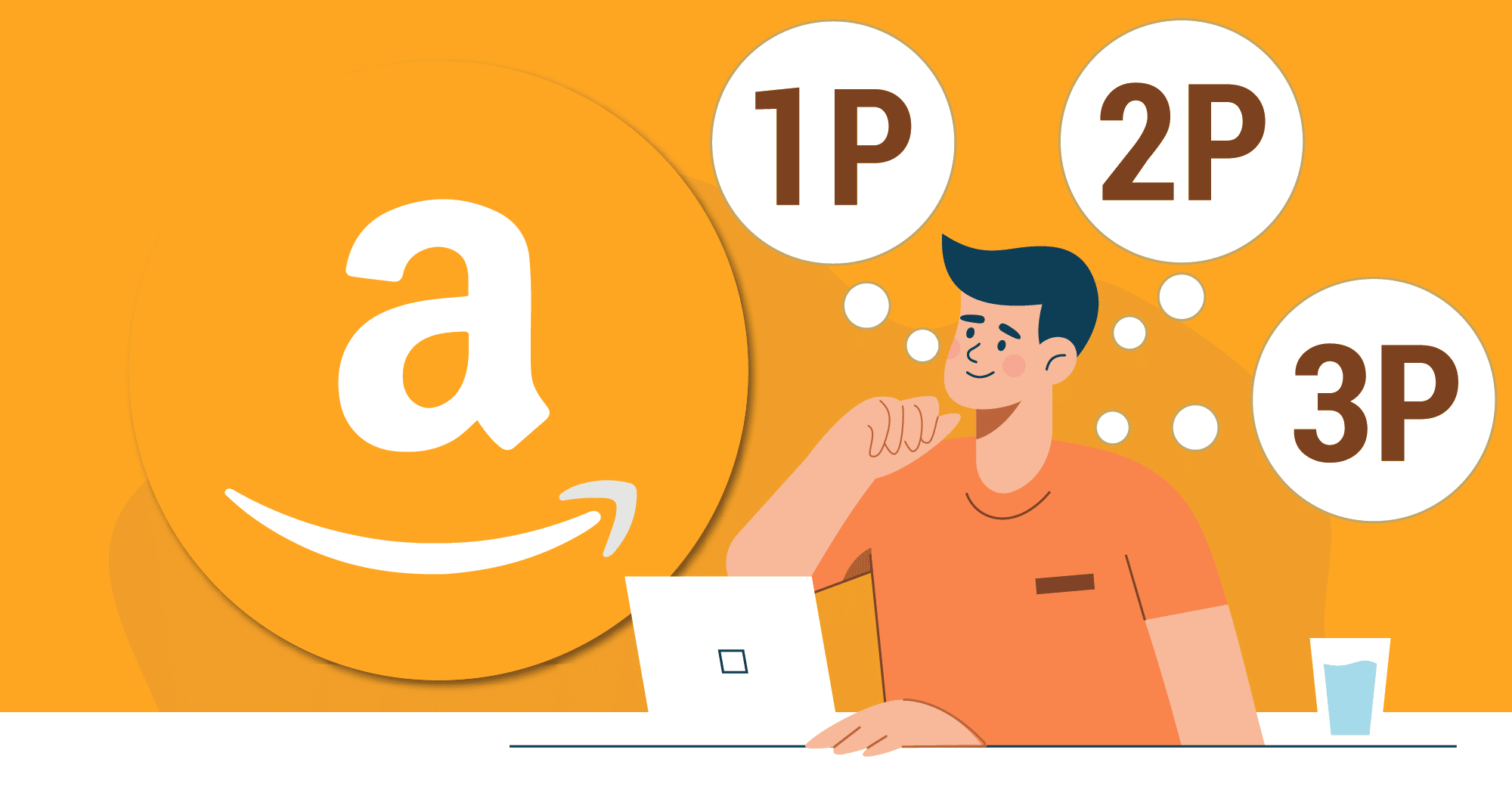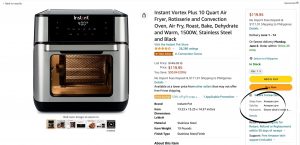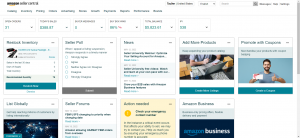Amazon 1P vs 3P Sellers: What’s the Difference?

If you’re unfamiliar with the Amazon arena, there are two relationships you can have with the platform as a seller: 1P and 3P.
For newbies, these terms can be a bit confusing at first. To simplify things, we break down the significant differences among these two selling models, including their pros and cons:
Contents
What Are 1st Party (1P) Amazon Sellers?
If you’re a first-party seller, it means you are selling to Amazon. The transaction occurs exclusively between you and Amazon as the wholesale seller and retailer, respectively.
To be a 1P seller, however, you need to be invited by Amazon directly. The process starts with Amazon sending a purchase order and you fulfilling that by shipping the products to them.

OR 10% OFF Every Month When You Use Code: ECOMCREW10
Once you’ve signed onboard as a 1P seller, ownership of your product/s is relinquished to Amazon, which means they have control over pricing. You still have liberty to make edits on the listings (which they make for you anyway) as well as run promotions.
In terms of liabilities, the manufacturer is ultimately liable and responsible for their products. Almost all retailers will require their manufacturers to hold liability insurance. Technically, Amazon has always required sellers to hold liability insurance but it wasn’t until last year, when they strictly enforced it.
You can tell a product is sold via 1P arrangement because the listing indicates that it is both shipped from and sold by Amazon.com. Here’s an example:
1P sellers access their accounts through Vendor Central, as opposed to Seller Central, which is exclusive for 3P sellers. Vendor Central is the portal used by Amazon to process transactions with its suppliers. It allows you to check the status of POs, search for product information, and check analytics.
As a 1P seller, you can also tinker with advertising tools, where you can create product display ads, as well as sponsored product and brand ads so more customers see your products. For 3P sellers, only buy box winners have access to these.
If you prefer a more hands-off setup as a seller and don’t mind the lack of control over your products, 1P is the way to go.
Pros and Cons of Being a 1P Amazon Seller
Pros
- Amazon orders your products in bulk.
- Customer confidence is significantly higher among 1P ASINs due to brand recognition.
- Product detail pages crafted by Amazon’s team are optimized.
- More advertising options are available.
- Products under 1P are automatically eligible for Prime perks such as two-day shipping. 3P sellers can also qualify for Prime, but it would entail a longer process through Seller Fulfilled Prime or FBA Onsite.
- You don’t have to worry about logistics.
- You’re basically free of inventory risk.
Cons
- Once you turn over your products, you no longer have control over them, from branding to pricing.
- Since you are selling wholesale, profit margins are lower.
- Payments are done farther apart, usually once a month, sometimes in longer intervals.
- Failure to comply with POs may incur chargebacks.
- Your inventory is entirely dependent on the POs.
Is There a 2P Amazon Seller?
Yes, there is! However, it is definitely not as common and straightforward as the other two models. This setup is mostly a means to augment inventory.
A second party (2P) relationship means that an Amazon supplier is not necessarily the manufacturer. The merchant of record (MoR) is Amazon, but the inventory is sourced through a reseller.
Essentially, a brand sells its products to a distribution partner and then a retailer (Amazon, in this case) buys from that partner.
Similar to 1P sellers, these items appear with the label “Ships from and sold by Amazon.com”.
What Are 3rd Party (3P) Amazon Sellers?
Third-party Amazon sellers sell through Amazon. You’re simply using Amazon as a channel to get more eyeballs on your products.
Third-party sellers have the liberty of choosing how to fulfill orders: either Fulfillment by Amazon (FBA), Fulfillment by Merchant (FBM), or Seller Fulfilled Prime (SFP).
Related reading: The Ultimate Guide to Being Merchant Fulfilled on Amazon
FBM means you as the merchant will handle the logistics. Keep in mind, without a team, this option can be a lot to handle on your own. Check out this ultimate guide on how to find a 3PL.
You can also watch this short video on choosing the best 3PL location for your business:
Thus, many sellers opt for the best compromise: FBA. From packing to shipping (and returns), Amazon does these parts of the process for you.
SFP, on the other hand, is the Prime program that allows a 3P seller to deliver directly to domestic Prime customers from their own warehouse.
While 1P sellers transact with Amazon through Vendor Central, 3P sellers have Seller Central.
Third-party Amazon sellers can choose between two seller accounts: Individual and Professional. With a more comprehensive set of features, most sellers opt for the latter. You can even have multiple seller accounts, as long as you have a legitimate business need.
Some of the key advantages of a Professional Seller Central account is that you can create listings in bulk using inventory files, manage inventory through feeds, spreadsheets, and reports, and most importantly, have the eligibility to win the highly coveted Buy box.
Pros and Cons of Being a 3P Amazon Seller
Pros
- You have total control over your prices and adjust them whenever necessary.
- You have autonomy over your brand and how it’s represented on the platform.
- Profit margins are better.
- You have better protection through the Brand Registry.
- You have access to a wealth of data to make better strategies.
Cons
- Inventory risk is all on you.
- You’re responsible for creating and optimizing your listings, as well as running ad campaigns.
- A larger bandwidth is required to use the Seller Central portal.
- You will be at the mercy of many additional expenses such as referral, fulfillment, and variable closing fees.
- You are responsible for customer service, which means you have to address all queries and complaints yourself, or your account could get suspended.
Can a Seller Be Both a 1P and 3P Seller?
Yes! As a seller, you do have the option to sell some products to Amazon and some products on Amazon.
In fact, many sellers adapt a hybrid approach, wherein they take advantage of both 1P and 3P features.
Let’s say you prefer more control over pricing and inventory for certain products, but also want Amazon to take charge of fulfillment for the more in-demand items.
Products that don’t do well under a 1P setup might do better under 3P. This approach is also a great way to test out new products.
The Breakdown
To recap, here are the main differences between 1P and 3P relationships in a nutshell:
Pros
- Less profit margins because products are sold at wholesale price.
- You have no control over pricing.
- You’re free of inventory risk.
- Product listings are taken care of.
- “Ships From and Sold by Amazon” badge establishes instant customer confidence.
Cons
- Profit margins are better because you’re selling retail.
- You have more control over your brand overall, from listings to promotions.
- It requires a lot of work and overhead, especially if you opt for FBM.
- There are several fees and additional costs to think about.
- You have access to a robust data and insights tool.
Final Thoughts
There isn’t exactly a better option between 1P and 3P Amazon sellers. Deciding what arrangement you’ll have as a seller on the platform will ultimately depend on your preferences and needs as a business.
You’ll need to ask yourself: Will I be okay with giving Amazon full control over my products or would I rather keep ownership of my brand even if it means I have to shoulder more responsibility?
What setup worked for your business best? Have you tried shifting from 1P to 3P?
Share your thoughts with us in the comments!






